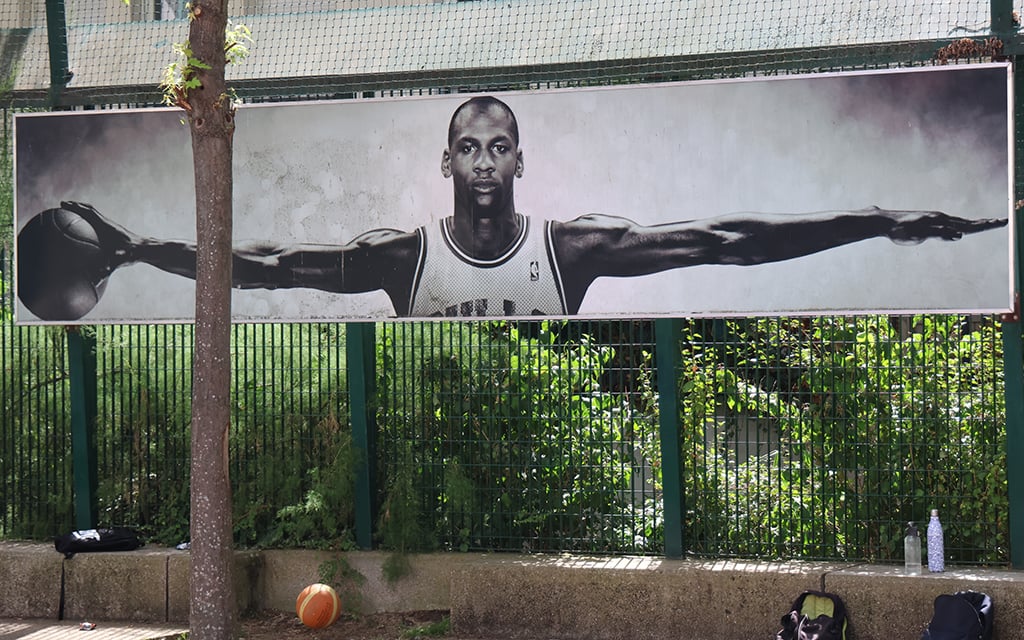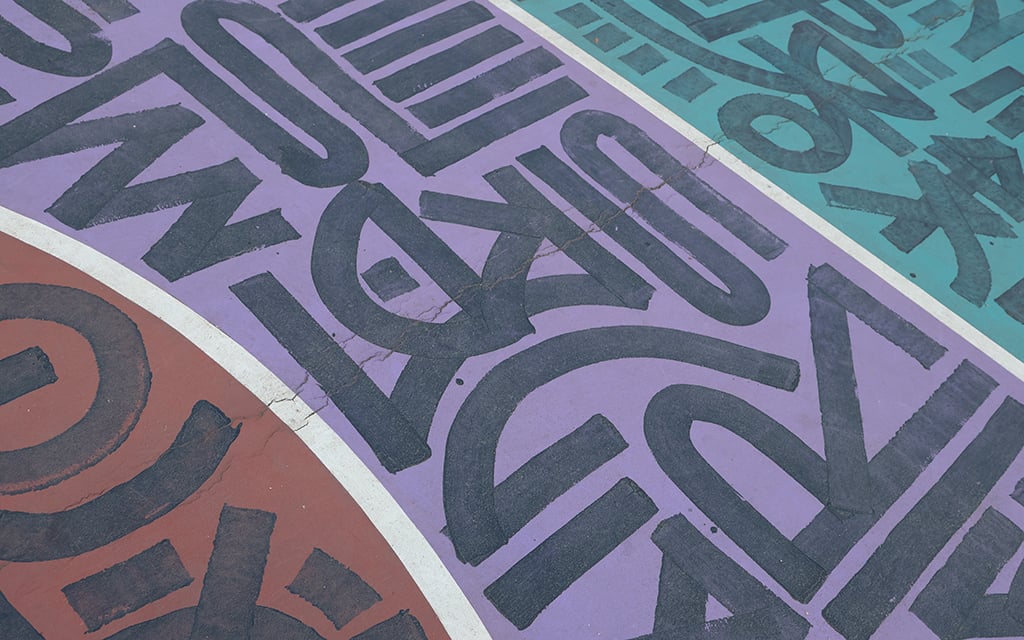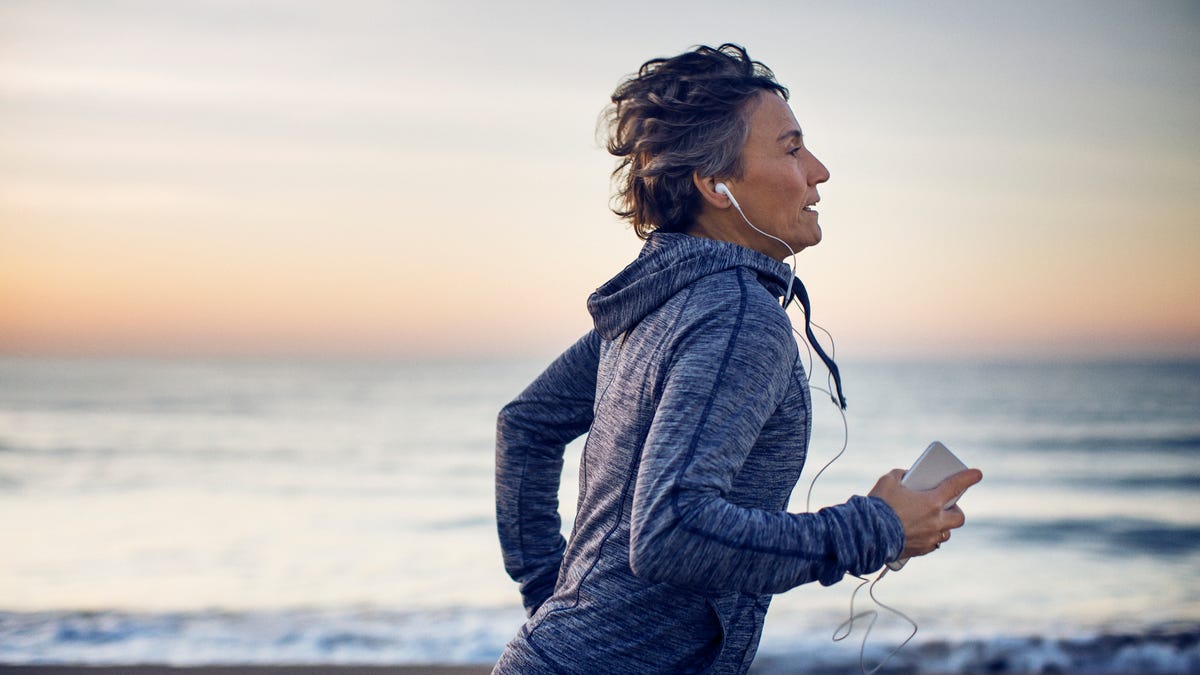Sports
Olympics bring vibrant sports courts to Paris’ often forgotten neighborhoods

Locals play basketball on a freshly painted basketball court at the Terrain de Sport Lagny park in Paris’ 20th arrondissement. (Photo by Zach Bradshaw/Cronkite News)
PARIS – The enhancement of sports facilities at the Paris Games wasn’t limited to Olympic venues.
The City of Paris also reinvigorated community sports courts, a vital component of any neighborhood’s urban culture.
This isn’t a new concept. When Phoenix has hosted big events, professional leagues and local organizing committees often contribute money to improve youth fields and and athletic structures. But it was particularly important in Paris, where updating the sports landscape requires a deft touch in a city knows for its one-of-kind architecture.
At Terrain de Sport Lagny, a park and sporting area in Paris’ 20th arrondissement, the basketball court has undergone a complete revitalization. What was once a plain, dated court has been painted with vibrant hues of yellow, purple and blue, and painted basketball hoops were added.
These new, colorful spaces have been dubbed “artistic playgrounds.” And the Olympics were the inspiration for the revitalization project.
“The idea comes from the ambition that we had around the Olympic and Paralympic Games to set up a useful and impactful legacy for Parisians,” said Boris Vassaux, Legacy and Engagement Officer for the General Delegation for the Olympic and Paralympic Games. “I am so proud and so happy that it … went from a sport for kids from working class neighborhoods to an Olympic discipline that shines throughout the world.”
The new sports courts can be used for any sport. Soccer, tennis, basketball.
And their designs were influenced by international athletic superstars. Michael Jordan, Magic Johnson, Larry Bird, Victor Wembanyama.
“The Stalingrad playground in the 19th district … that’s where we grew up and we started to play basketball in the early 90s,” said Paul Odonnat, co-founder of Panagon, the company behind the sports courts designs. “We are really fans of hip hop music. So this is our influences, our urban culture, and that’s how we mix them all together to design these playgrounds.”
Panagon, the company Odonnat and business partner Bakary Sakho co-founded, has collaborated with the City of Paris to revitalize urban spaces across the city.
Since 2019, Paris has revitalized 81 municipal parks, which are visited by roughly 50,000 people annually, Vassaux said.
“We use the Olympic and Paralympic Games to renovate areas with a new floor, with new basketball goals,” Vassaux said. “Now, we have better places for doing sports. And so we are very proud to have this legacy for everybody in Paris.”
Officials and locals appreciate that the courts bring light to Paris’ least-acknowledged neighborhoods – the parts of Paris that are often unseen.
Photos of the city often show the Eiffel Tower, the Arc de Triomphe or the iconic Louvre Museum, the picture-perfect spots that tourists attribute to being Paris.
But what the locals see is different. It’s not always the glitz, the glam and the glorious monuments.
Paris has obstacles that any other city has. Drugs, violence, crime.
Iza Van Dyke, 26, sees the under-the-radar obstacles every day and brings attention to an underlying sentiment regarding the Olympic Games.
“None of this was here before the Olympics,” Van Dyke said. “They changed everything – the trees, the gardens, all of the nice things here are new.”
She can’t shake that feeling that these beautification efforts are for show and “seem kind of fake.” Homeless people in the area were moved out along with the clean-up projects, which signifies a false image of the neighborhood for her.
Van Dyke lives in the 10th arrondissement and plays basketball at the Jardin Villemin courts near the Canal Saint-Martin practically daily. She mentions being jeered at and having to carry pepper spray everywhere with her because of the “dangerous activity and people” in the 10th arrondissement.
“Sometimes on the way here, I see many sad things,” she said. “The area by the (Gare de l’Est train) station, it can be rough to see all the people suffering from poverty, drugs, violence.”
The park in many ways, however, is a safe haven for the neighborhood’s kids and residents. It’s a space where they can play sports and connect with each other.
“Everyone can come here and connect with the others,” she said. “There are good people always around, it’s a good place for the kids. … Everyone can come here, everyone is welcome.”

A colorful design highlights the basketball court at the Terrain de Sport Lagny park in Paris. With the Olympics came a need to revitalize many parts of the community. (Photo by Zach Bradshaw/Cronkite News)
The refreshed paint jobs have brought new life to the park and its sports courts.
“I come here, there are paintings, there are colors, people smiling, having fun,” she said. “It brings some joy to my heart. … When you come here, it’s all redecorated. … It’s beautiful, it revives the great atmosphere.”
And the sports courts are here to stay.
What’s best about the courts, Vassaux said, is they’ll play a large part in Paris’ attempts to revitalize underserved and impoverished communities.
“Whatever our skin color, whatever our origins, whatever our religions, whatever our ages, we can bring together France and the French youth,” Vassaux said. “The idea was to have a lever for transforming the entire neighborhood.”
A specific goal laid out was to encourage sports participation for women and girls, who may not feel there is a level playing field because of a lack of athletic spaces.
“Girls practice as much as boys, but from 13 to 16 years old, there is a drop in female practice, for cultural reasons, for youth issues and so on,” Vassaux said. “So we proposed this challenge of how to promote sport and fight against the scene.”
They even painted a female basketball player on the court at the Playground Charles Moureu in the 13th arrondissement.
What the revitalized urban spaces will do, Vassaux said, is help put girls “in touch” with their neighborhood’s sports atmosphere. With more available spaces for sport, more people can participate.
Paris is also using influencers to promote its invigorated sports environment. In 2015, after a similar court revitalization project was carried out, international basketball legend Michael Jordan and Paris Mayor Anne Hidalgo helped inaugurate the opening of a new urban park at the Terrain des Haies in the 20th arrondissement.

A homage to Michael Jordan can be found at the Terrain des Haies park in Paris’ 20th arrondissement. The addition is an attempt by the city to revitalize local parks. (Photo by Zach Bradshaw/Cronkite News)
Not only are the sports courts promoted by influencers, by they were painted with international stars in mind. Players such as Wembanyama and Jordan are not only basketball inspirations, but they’re inspirations to the youth in Paris, Odonnat said.
“The impact of this playground is all over the city, since Paris is a city really, involved in sports, both at the local level… and pro athletes and international level,” Odonnat said. “It’s not only an impact on the city, but also on the Paris brand all over the world.”
Criticism over city’s efforts
A common criticism of the Olympics involves legacy and what is left behind. As many host cities have had issues with keeping newly built stadiums running and having to navigate the negative impacts of the investment in the Olympic games themselves, the IOC requires legacy planning as part of every Olympic bid. Cities not only have to curate a plan for hosting the Games successfully, but also for creating a positive impact on their local communities.
The goal is to change the narrative that the Olympics are an event that cities should run away from financially.
Boris Vassaux, legacy and engagement officer for the general delegation for the Olympic and Paralympic Games, mirrors the sentiment around the megaevent.
“The Olympics were very expensive. There are white elephants and equipment that are not used by the residents,” Vassaux said. “So we wanted to have the cheapest Olympic Games possible with a single creation – the DS arena.”
Making the games more sustainable has been just as important as making the games accessible and transformative for locals. Neighborhoods like La Chappelle, La Courneuve and London-Stratford have seen targeted revitalization projects with celebration zones, new sports courts, cleaning projects and renovations.
The Olympic organizers are looking for transformation.
Regarding the Paris Olympic legacy, Vassaux says it was his job to develop 38 “new municipal public devices,” which is around 450 associations being financed every year. The goal was also to create jobs or boost job prospects for 50,000 Parisians through the Olympics.
“Six million euros for 50,000 people who are either in precarious situations or from working class neighborhoods,” Vassaux said.
The initiative is supposed to help those in Paris with a low number of social associations or disabilities.
With the effort to increase job opportunities for locals, there was a widespread beautification of the city in preparation for the Olympic Games – a part of this process was the renovation of basketball courts and parks across the city.
Panagon, the agency largely entrusted to renovate and redecorate basketball courts across town, realized that they could expand their artistic expression and limits after seeing what Nike did with the Pigalle Duperey Playground, which was completed in 2017. This court, marked by ultra-colorful shapes and striking lines, became popular on Instagram.
Panagon would eventually partner with Nike and used the inspiration for other courts across Paris, including Stalingrad.
These renovated basketball courts can be found in many places, including Locksmith in the 19th arrondissement, Chacha at Leo Lagrange in the 12th, Claude-Bernard in the 19th, Charles Moureux in the 13th and Villemin Square in the 10th.
A big part of these projects is consultation with the residents.
“We do not want to make mistakes and do things that the inhabitants of working-class neighborhoods would not want,” Vassaux said. “Building artistic grounds in other territories, we had to be advised by experts.”
The idea is to carry out these projects with the help of locals.
Bakary Sakho, co-founder of Panagon, sees the significance of the fusion between urban culture and sports, with a good example being music and dancing in hip-hop. He hopes to continue the promotion of sport through culture.
This could be a feasible avenue for heightened participation in sports and physical activity.
“We are almost at 70% of French people who practice a sport,” Sakho said. “And we are trying to convince the other 30% to have a daily practice – half an hour of sport per day.”
Panagon is also trying to bring young kids together around the love for basketball through the All Parisian Games, which is sponsored by Nike and Jordan.
The organization has been able to get high-level athletes like Lebron James, Kobe Bryant and Jayson Tatum to attend these events, which provides access to global superstars that most underprivileged kids and teenagers do not have.
“It is more than a project, it is several events in the year,” Odonnat said. “Basketball courses, film screenings, exchanges around culture, basketball culture and cinema.”
Using basketball as a tool for education surrounding culture and giving the adolescents something to be proud of is their goal.
The All Parisian Games also played host to the NBA Cares program in 2021, which shows a significant tie to the NBA’s philanthropy.
As basketball was chosen as a tool to help underserved communities, other sports and activities are part of the plan as well.
“Today a basketball court is no longer used only to play basketball,” Sakho said. “It also becomes a space for cultural expression where we can diversify our activities.”
They believe this is a major reason to renovate all of these spaces, as basketball is the first thought but not the only sport or activity in mind. Realistically, the community can use the facilities how they desire.
“Designing land and just putting paint on the ground is not the most complex part,” Sakho said. “But it is how we make it a real heritage,”
They do this by staying true to the current “emblematic characters” and future inhabitants of a given area.
These renovated parks were not envisioned with just the youth in mind.
“Recreational players can be elderly people who just want to have a good time on a field designed with beautiful colors,” Odonnat said.









